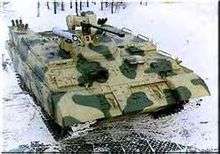BTR-T
| BTR-T | |
|---|---|
 Russian BTR-T | |
| Type | Heavy infantry fighting vehicle |
| Place of origin | Russia |
| Specifications | |
| Weight | 38.5 tonnes |
| Length | 6.45 m |
| Width | 3.27 m |
| Height | 2.4 m |
| Crew | 2 (+5 passengers) |
|
| |
| Armor | 320 mm max with ERA |
Main armament | 9M113 Konkurs ATGMs |
Secondary armament | 2A42 30mm autocannon or AGS-17 automatic grenade launcher |
| Engine |
diesel 520hp |
| Power/weight | 14hp/tonne |
| Suspension | torsion bar |
Operational range | 500 km |
| Speed | 50 km/h off-road: 25 km/h |
The BTR-T (Russian: Бронетранспортёр-Тяжелый (Bronetransporter-Tyazhelyy), ‘Armoured Transporter–Heavy’) is a Russian heavy infantry combat vehicle, designed by the Design Bureau of Transport Machine-Building (Omsk Transmash) state-run production association.
Description
It is based on the hull of the T-55 tank and answers the need for a heavy, well protected and well armed vehicle adapted to urban combat. The need for a heavy IFV appeared after the First Chechen War during which APCs like the BTR-80 and BMP-2 were annihilated in urban areas at the hands of Chechen rebels using RPG shoulder-launched anti-tank weapons. Consequently, the design incorporates thicker armour, with built-in reactive armour. It also has heavier armament with sufficient elevation to engage targets in multi-story buildings.
Design
The choice of the T-55 hull rather than that of a more modern tank was decided as a cost-cutting measure and also probably in order to validate a conversion solution for the many T-55s in use around the world. It was influenced by Israel's IDF Achzarit that created virtually the same modifications in the 80s. However, no export contracts have been signed so far.
Armament
The turret can accommodate several weapon configurations:
- 2A42 30 mm autocannon.
- 9M113 Konkurs ATGMs.
- 2A42 30 mm autocannon.
- Twin 2A38 30 mm autocannons.
- 12.7×108 mm NSV heavy machine gun.
- 9M113 Konkurs ATGMs.
- 12.7×108 mm NSV heavy machine gun.
- 30 mm AGS-17 automatic grenade launcher.
See also
- IDF Achzarit
- BMPT Terminator
- VIU-55 Munja
- BMPV-64 ru:БМПВ-64/uk:БМПВ-64: A Ukrainian heavy infantry combat vehicle based on the T-64 chassis